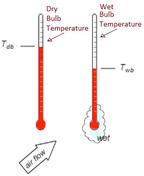Resistive vs. Capacitive Hygrometers: A Detailed Comparison
Advertisement
This article dives into the differences between two common types of hygrometers: the resistive hygrometer and the capacitive hygrometer. We’ll explore their construction and working principles, helping you understand how they measure relative humidity.
Understanding Relative Humidity
Relative humidity (RH) is a measure of the amount of water vapor in the air compared to the maximum amount of water vapor the air can hold at a given temperature. It’s expressed as a percentage. Various methods exist for measuring RH, including:
- Galvanometric Hygrometer
- Resistive Hygrometer
- Capacitive Hygrometer
- Microwave Refractometer
- Aluminum Oxide Hygrometer
- Sling Psychrometer
- Crystal Hygrometer
Let’s focus on the resistive and capacitive types.
Resistive Hygrometer
How it Works
Resistive hygrometers rely on the principle that the electrical resistivity of certain materials changes with humidity levels.

- As shown in the figure above, these hygrometers typically use a hygroscopic salt, like Lithium Chloride (LiCl), as their core sensing element.
- The resistance of this material varies dramatically with humidity. It can range from around 10^4^ ohms at 100% RH to approximately 10^9^ ohms at 0% RH.
- When the air has higher relative humidity, the LiCl absorbs more moisture, which reduces its resistance. Conversely, lower humidity leads to less moisture absorption and higher resistance.
- This change in resistance is measured and translated into a humidity reading.
Capacitive Hygrometer
How it Works
Capacitive hygrometers, on the other hand, take advantage of changes in a material’s dielectric constant due to moisture absorption.

- As seen in the figure above, these hygrometers employ a hygroscopic material placed between the parallel plates of a capacitor.
- The dielectric constant of this material changes as it absorbs moisture from the air.
- A capacitive transducer detects these changes in dielectric constant, which is directly related to the humidity level.
- This change in capacitance is measured and converted to a humidity reading.
Key Differences Summarized
| Feature | Resistive Hygrometer | Capacitive Hygrometer |
|---|---|---|
| Principle | Resistance change with humidity | Dielectric constant change with humidity |
| Sensing Element | Hygroscopic salt (e.g., LiCl) | Hygroscopic material between capacitor plates |
| Measurement | Measures change in resistance | Measures change in capacitance |
In Conclusion
Both resistive and capacitive hygrometers are effective tools for measuring relative humidity, although they operate on different physical principles. The choice between them often depends on the specific application requirements, cost constraints, and desired accuracy.
Advertisement
 T&M
T&M 


